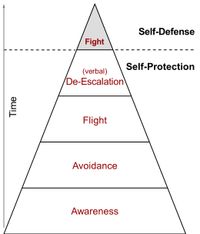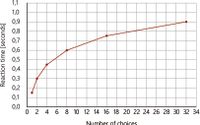Things to Know
Krav Maga
Krav Maga means »contact combat« in Hebrew (Krav: fight, Maga: contact) and is a modern self-defense system that is constantly being developed worldwide. The later Krav Maga was founded in the 1930s by Imrich Lichtenfeld (1910 - 1998) in Slovakia to protect the Jews living there against anti-Semitic attacks. The main elements of the system are punches, kicks, some holds and levers as well as ground techniques. Imrich Lichtenfeld emigrated from Slovakia in 1940 and arrived in the then British protectorate of Palestine via the British army in 1942. There, initially with British support, Lichtenfeld taught hand-to-hand combat to paramilitary Jewish forces and became a hand-to-hand combat instructor for the Israeli Defense Force (IDF) after the state of Israel was founded in 1948. The term Krav Maga was introduced there in 1949. First by Imrich Lichtenfeld and later by his students, the system then became known worldwide beyond Israel over the years.
Depending on the different areas of application, a distinction is now made between:
- Military Krav Maga
- Commercial Krav Maga
- Krav Maga for security forces and law enforcement agencies (e.g. police, public order office, customs).
Military Krav Maga mainly contains hard and uncompromising techniques, while Krav Maga for security forces and authorities mainly uses soft, non-final techniques, as well as levers, fixation and transportation holds. Commercial Krav Maga is a mixture of both and therefore offers the greatest variety in terms of technical options.
Combatives
The term »Combatives« is a made-up word derived from the (non-existent) plural of the English word »combative«. The roots of combatives lie in the close combat training of US soldiers during the Second World War. Combatives are understood to be the compilation of a deliberately small number of close combat and self-defense techniques. The basic principle is above all simplification, which is intended to achieve two goals:
- Fast learning curve
- Availability under high stress
Although originally designed for military use, combatives also cover all the individual escalation stages of a conflict from a self-defense perspective in the civilian sector, i.e. from recognizing and avoiding dangerous situations to communication strategies and de-escalation through to combat techniques and tactics.
Self-Defense
»Self-defense« is the term used to describe the defense against physical or psychological attacks in order to prevent harm to oneself. Self-defense in the form of a physical confrontation is the last resort when »nothing else works« and all previous steps have failed. ...
- Awareness,
- Avoidance,
- Flight,
- De-escalation
So the »fight« is therefore really only the very last option.
Self-Assertion and Self-Defense
»Self-assertion« is the ability to successfully assert or claim one's own needs and demands against others without physical contact. In contrast to self-defense, no physical defense techniques are applied, but only communicative skills are used, i.e. voice, facial expressions and body language.
Self-Defense and Combat Sports & Martial Arts
The main difference between self-defense and martial arts or combat sports is that it doesn't have to look pretty, there's no referee and no points - it's all about getting out of a dangerous situation as quickly and as unharmed as possible.
And above all:
There are no rules !
Fear
Fear is an important protective mechanism in humans and animals, which is intended to ensure physical or mental integrity and, in extreme cases, survival in real or even perceived dangerous situations. Fear is supposed to prepare a living being for a fight-or-flight situation. This releases various hormones, including adrenaline in particular, which accelerates many body functions. The most significant physical effects are:
- Sharpening of the senses, pupils dilate and visual and auditory nerves become more sensitive (for increased perception).
- Restricted field of vision (»tunnel vision«).
- Increased reaction speed, muscle tension, and energy provision in muscles (to prepare for fight or flight).
- Increased pulse; depending on the situation and constitution, the pulse can easily rise to over 200 beats per minute.
From a pulse of approx. 175 beats per minute onwards, only gross motor movements are possible! - Increased blood pressure.
- Shallower and faster breathing.
- Sweating, trembling and dizziness, teeth grinding, shivers of heat or cold, possibly also nausea or shortness of breath.
- Suppression of digestive and sexual functions (to save energy).
- If necessary, emptying the bladder (in preparation for fight or flight).
- Faster blood clotting (to minimize possible blood loss).
For self-defense it is important a) to be aware of these (completely natural) reactions and b) to prevent a physical »freezing« by appropriate training
and to use the available energies positively in the sense of »flight« if possible and otherwise of »fight«.
Action vs. Reaction
In 99 out of 100 cases, an action is always faster than a reaction. For self-defense, it follows that when an attack is inevitably imminent, the defender should not wait until the attack actually occurs in order to only then fend it off, but that he should instead take the initiative himself from the outset and attack the attacker first (so-called »preventive attack«).
Preventive Attack
At the very latest, when the attacker has approached the defender to within kicking distance or even arm's length, regardless of the defender's clear attempts at de-escalation, all further thoughts regarding fight avoidance that may still be going through the defender's mind ("Will he really attack or not?"; "Shouldn't I better do something now, or would it still be better to wait?"; "What can I do best now?“; etc.) have become completely obsolete.
If the defender still believes at this point in time that he can really »defend« himself in case of an attack, he must assume that he will at least take the first punch, kick, head or knee strike of the attacker ... and can then only hope to still be able to act afterwards to the extent that he can ward off subsequent attacks and avoid further damage. However, the probability for this is not very high ... Finish.
If it will come to a physical confrontation anyway, attack is actually the »better« defense! As described in the previous section, an action is usually faster than a reaction, which allows the defender to significantly improve his chances for a successful defense by a preventive attack just only once. However, this attack must never be done half-heartedly, but must be followed through with full consequence until the end of the self-defense situation. Otherwise, the attacker can recover too quickly from the moment of surprise and continue his own attack all the more violently after this forewarning. Under this premise, every preventive attack must always be carried out with the absolutely clear intention not to start a »fight«, but to end the emerging dangerous situation as early as possible in the development phase.
Hick´s Law
Hick's Law was developed in 1952 by William Edmund Hick (British physician and psychologist, 1912 – 1974) and describes the relationship between the reaction time and the number of possible choices. Roughly speaking, the law states that for every doubling of the number of possible choices, the reaction time increases by about 150 ms. Independent of the number of choices, however, the reaction time adjusts to a fixed value through regular practice.
Applied to self-defense, this means that when an attack is in progress, the more defensive techniques are available to the defender and the more
decisions he must make to select the most suitable technique for that attack, the longer the reaction time will be.
Conclusion: It is better to master just a few techniques than to know many techniques but not really be able to do them..



